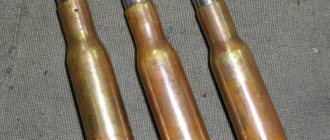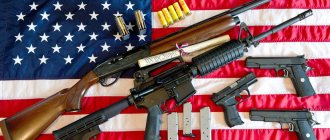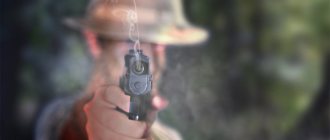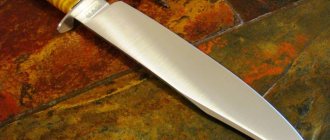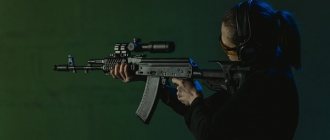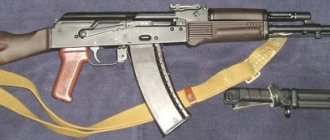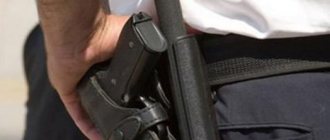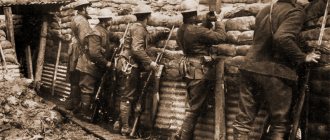Hourly. Sentinel immunity. Rights, duties and subordination of a sentry
1.1. Hourly.
119. ... A sentry is an armed guard who performs the combat mission of protecting and defending the post assigned to him.
1.2. The inviolability and subordination of the sentry.
204. The sentry is an inviolable person. The immunity of the sentry is:
- in the special protection by the legislation of the Russian Federation of his rights and personal dignity;
- in his subordination to strictly defined persons - the chief of the guard, the assistant chief of the guard and his guard;
- it is the duty of all persons to unquestioningly fulfill the requirements of the sentry determined by his service;
- granting him the right to use weapons in the cases specified in this Charter.
205. Only the chief of the guard, the assistant chief of the guard and the guard to whom the sentry is subordinate have the right to replace or remove the sentry.
In the event of a serious illness (serious injury), death of the guard chief, his assistant and the guard, or physical impossibility for them to perform their duties, the removal or change of the guard is carried out by the duty officer of the garrison (military police department, military unit) in the presence of his company (battery) commander or battalion (division).
1.3. Rights and responsibilities of a sentry.
206. When entering a post, the guard must, in the presence of the guard (chief of the guard or his assistant) and the guard being replaced, personally inspect, check the presence and serviceability of everything that must be guarded and defended according to the checklist of posts.
207. The sentry is obliged:
- vigilantly guard and steadfastly defend your post;
- serve cheerfully, not be distracted by anything, not let go of the weapon and not give it to anyone, including the persons to whom he is subordinate;
— moving along the specified route or being on the observation tower, carefully inspect the approaches to the post, the fence and report via communications on the progress of the service within the time limits established by the post report card;
- do not leave his post until he is relieved or removed, even if his life is in danger; unauthorized abandonment of post is a crime against military service;
- have weapons at the post loaded according to the rules specified in Article 125 of this Charter, and always ready for action;
- do not allow anyone to approach the post closer than the distance specified in the post report card and indicated on the ground by signs of the forbidden border, except the chief of the guard, the assistant chief of the guard, his guard and the persons they accompany;
- know the routes and traffic schedules of guard vehicles, as well as their identification marks and signals;
- know the advance routes, identification marks (signals) of the reserve guard group and the duty unit, the lines they occupy and positions near the post;
— be able to use the fire extinguishing equipment at the post;
- call the chief of guard if a malfunction is detected in the fence of the facility (at the post) and violations of order near his post or at a neighboring post;
- upon hearing the barking of a guard dog, as well as when technical security means are activated, immediately report to the guardhouse.
208. The sentry at the post must have a weapon with an attached bayonet-knife (bayonet), while a machine gun with a folding butt - without a bayonet-knife, a bayonet-knife - in a sheath on the waist belt: at night - in the ready position for shooting while standing; in the daytime - in the “on the belt” position or in the ready position for standing shooting (see pictures). At internal posts and at the post near the Battle Banner, an assault rifle with a wooden butt should be in the “on the belt” position, an assault rifle with a folding butt should be in the “chest” position, a carbine should be “to the leg” (the bag with the loaded magazine (clips) should be buttoned), the pistol is in a buttoned holster on the waist belt.
In the event of extinguishing a fire or eliminating the consequences of a natural disaster, the sentry is allowed to have a weapon in the “behind his back” position.
Position of the machine gun at the sentry when ready to fire while standing
The position of the machine gun at the sentry when ready for shooting while standing using a belt
The position of the sentry's carbine when ready to fire
The position of the guard's weapon when wearing a raincoat
209. The sentry is prohibited from: sleeping, sitting, leaning against anything, writing, reading, singing, talking, using personal means of communication, eating, drinking, smoking, performing natural needs or otherwise being distracted from the performance of his duties, accepting from anyone be that as it may, and hand over any objects to anyone, cause by one’s actions the activation of technical security means, and unnecessarily send a cartridge into the chamber.
The sentry must answer questions only from the chief of the guard, the assistant chief of the guard, his guard and the persons who arrived for inspection.
214. In the event of a fire at the guard post, the guard immediately reports this to the guardhouse and, without ceasing to monitor the protected object, takes measures to extinguish the fire. In the event of a fire in the technical territory of a protected facility or in a facility that has external and internal fences, as well as near the post, he reports this to the guardhouse, continuing to serve at the post.
215. In the event of a sudden illness (injury), the sentry calls the guard or the chief of the guard, continuing to serve.
216. In extreme, urgent cases or in the event of a malfunction of communication means, the sentry may call the head of the guard or the guard with a shot upward to the post.
217. The sentry, upon arrival at the post of the commanders to whom he is subordinate, reports to them on the results of his service.
For example: “Comrade Lieutenant. No incidents happened while on duty (or something happened).” At the same time, the sentry greets them, as well as the commanders who arrived at the post accompanied by them, according to the rules set out in the Drill Regulations of the Armed Forces of the Russian Federation. In this case, the machine gun from the standing shooting position is first taken “on the belt”, and the carbine is “on the leg”.
Charter of the Garrison and Guard Services of the RF Armed Forces
approved by Decree of the President of the Russian Federation of November 10, 2007 N 1495
124. Loading of weapons is carried out before going to posts, for escorting military personnel kept in the guardhouse and in disciplinary military units, for escorting military personnel outside the guardhouse (disciplinary military unit), as well as for escorting persons checking the guard.
Loading and unloading of weapons is carried out at the command of the guard chief or his assistant (dispatching) and under their direct supervision at the guard room in a specially equipped and illuminated place with a bullet catcher, and when shifts follow to posts on vehicles - in the places specified in the instructions to the chief guards, if necessary also equipped with bullet traps. When loading and unloading, the barrel of the weapon should be directed upward (at an angle of 45 - 60°) and away from the surrounding residential premises and the protected object. If residential and service premises are located near and around the guardhouse, loading and unloading of weapons can be carried out in the guardhouse, in a special place equipped with a bullet trap. Unloading and inspection of weapons are carried out immediately upon returning to the guardhouse or in the places specified in the instructions to the guard commander.
Pistols are loaded after receiving cartridges in the unit, and unloaded after the changing of the guard upon his arrival at the unit.
125. The weapon is loaded according to the rules specified in the shooting manuals for the corresponding types of weapons, and the cartridge is not sent into the chamber.
The machine gun is loaded with a loaded magazine. Before loading, it is inspected (at the same time the trigger is released) and the safety is put on. The bolt frame does not move back after attaching the magazine.
The carbine is loaded with a magazine loaded to its full capacity. After loading the carbine, the bolt closes smoothly (without sending a cartridge into the chamber), the safety is removed, the trigger is released, and the carbine is put on safety.
The pistol is loaded with a loaded magazine; the bolt does not retract when loading. Before loading the pistol, put the safety on.
Machine guns and hand grenades are loaded immediately before they are used.
Charter of the Garrison and Guard Services of the RF Armed Forces
approved by Decree of the President of the Russian Federation of November 10, 2007 N 1495
Actions of a sentry in special situations
In addition to the regular schedule of service, the charter also provides for regulations for special situations. These include force majeure circumstances - fire, injury, illness. For all such cases, the key aspect is to immediately report to the guardhouse. If it is impossible to do this, as well as if communication means are broken, it is allowed to shoot in the air.
Fire at the post or adjacent area
If a fire occurs at the post, the sentry reports it to the chief of guard, after which he begins to extinguish it. In this situation, the weapon can be moved to the “behind the back” position. At the same time, the guard should not lose vigilance in protecting the entrusted post.
In the event of a fire in the technical territory of the post, near it or at an object with external and internal fences, the sentry is limited to reporting it to the guardhouse. After this, he continues to serve as a security guard for the entrusted facility.
Illness or injury of a sentry
In the event of an exacerbation of the disease or injury, the sentry also contacts the guardhouse. After this, he continues to serve until the guard arrives with a replacement guard.
In case of breakdown of technical equipment
The failure of technical security equipment is usually recorded by operators in the guardhouse. If such problems are detected at the post, the sentry reports them to the chief of the guard. After this, he continues to serve, remaining vigilant.
The procedure for using weapons by a sentry
210. The sentry is obliged to use weapons without warning in the event of an obvious attack on him or on the object he is protecting, as well as in the case of an immediate threat of attack (physical pressure), when delay in using weapons creates an immediate danger to people’s lives or may entail other serious consequences. consequences. At the same time, the use of weapons should not cause harm to the protected object or third parties.
211. All persons approaching the post or the forbidden border of the post, marked on the ground with signs, except for the chief of the guard, the assistant chief of the guard, his guard and the persons accompanied by them, are stopped by the sentry shouting “Stop, go back” or “Stop, go around to the right ( left)".
If this requirement is not met and the forbidden border of the post is crossed, the sentry warns the offender with the shout “Stop, I will shoot” and detains him. The sentry reports the arrest of the violator to the guardhouse, monitors his behavior and, without weakening his attention, continues to guard the post assigned to him.
If the intruder, after the warning “Stop, I’ll shoot,” continues to move, the sentry places a cartridge in the chamber and fires a warning shot upward. If the offender fails to comply with this warning or if he flees, the guard will use a weapon against him.
212. In conditions of poor visibility, when from the distance indicated in the post report card it is impossible to identify those approaching the post or the forbidden border of the post, the sentry stops all persons by shouting “Stop, who is coming?” If there is no response and (or) the violator crosses the forbidden border of the post, the sentry warns him with the shout “Stop, I’ll shoot” and detains the violator. The sentry reports the arrest of the violator to the guardhouse, monitors his behavior and, without weakening his attention, continues to guard the post assigned to him.
If the intruder, after the warning “Stop, I’ll shoot,” continues to move, the sentry places a cartridge in the chamber and fires a warning shot upward. If the offender fails to comply with this warning or if he flees, the guard will use a weapon against him.
When the guard’s shout is answered: “The chief of the guard (assistant chief of the guard, guard) is coming,” the sentry orders: “Chief of the guard (assistant chief of the guard, guard), come to me, the rest are in place”; if necessary, the sentry requires that those approaching him illuminate his face. Having made sure that the one who introduced himself is really the chief of the guard (the assistant chief of the guard, the guard), the guard allows him and all the arriving persons to come to him.
If the one who identified himself as the guard chief (assistant guard chief) turns out to be unknown or those with him do not comply with the sentry’s demands to remain in place, the sentry warns the violators with the shout “Stop, I’ll shoot.” If the violators fail to comply with this requirement, the sentry uses a weapon against them.
213. If it is necessary to engage in hand-to-hand combat to protect himself or a protected object, the sentry must boldly use a bayonet-knife (bayonet) and a butt.
Charter of the Garrison and Guard Services of the RF Armed Forces
approved by Decree of the President of the Russian Federation of November 10, 2007 N 1495
What should a sentry on duty be prepared for?
Carrying out guard duty at a post is a responsible position that requires discipline and responsibility. In this regard, the following categories of military personnel are not accepted into guard duty:
- not taken the Military Oath;
- have not completed the training program;
- those who have committed actions with signs of a crime that are still under investigation;
- prone to drinking alcohol, narcotic, psychotropic or other intoxicating and toxic drugs;
- those who received the third or fourth group of neuropsychic stability;
- patients, including cases of moral and psychological disorder;
- brought to criminal liability;
- those experiencing loss in the family;
- experiencing fear, depression, anxiety, and also prone to increased conflict.
These regulations show the importance of guard duty. While remaining on duty, the sentry must remain vigilant under all conditions and circumstances. In a number of cases, he is required to demonstrate perseverance and firmness. Knowledge of the provisions of the charter on guard duty and the duties of a sentry is also taken into account.
In accordance with the performance of the combat mission, the sentry is obliged to use weapons in the cases provided for by the charter. To do this, in addition to well-trained skills, he also requires the ability to assess the situation.



